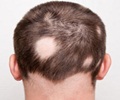Unexplained hair loss can take a significant psychological toll on the overall quality of life in women.
Unexplained hair loss can take a significant psychological toll on the overall quality of life in women.
From altering their hairstyle to hide a thinning part to scaling back their hair care regimen in an effort to halt further hair loss, women try countless ways to cover up this problem - and the results are often lukewarm at best. A better option is to see a dermatologist, a physician trained in the care of skin, hair and nails, who can diagnose and, in many cases, successfully treat hair loss in women.Speaking today at the 68th Annual Meeting of the American Academy of Dermatology (Academy), dermatologist Mary Gail Mercurio, MD, FAAD, associate professor of dermatology and program director of dermatology residency at the University of Rochester in Rochester, N.Y., discussed common forms of hair loss in women and available treatment options.
"In the past, many women experiencing hair loss would suffer in silence, not knowing where to turn for help and trying their best to hide the problem," said Dr. Mercurio. "But now, I see more and more women in my practice seeking treatment for hair loss and actively addressing this condition. That''s encouraging, as the sooner hair loss is diagnosed, the better our chances of successfully treating it."
Female-Pattern Hair Loss: Highly Common, Highly Treatable
The most common form of hair loss in women is female-pattern hair loss, which usually has a strong genetic component that can be inherited from either the mother or father. Also referred to as androgenetic alopecia, this type of hair loss can start as early as the late teens - and the earlier it starts, the more severe the hair loss tends to be.
While pattern hair loss affects both men and women, it is very different in women. For example, female-pattern hair loss is not characterized by a receding hairline or bald spot on top of the scalp as is common in men. In women, the frontal hairline is usually maintained, but there is visible thinning over the crown. In addition, in both men and women, hairs are miniaturized due to a shortened growth cycle where the hair stays on the head for a shorter period of time. These wispy hairs, which resemble forearm hairs, do not achieve their usual length.
"For women, the first sign of hair loss that they often notice is a widening of their part or their ponytail is smaller," said Dr. Mercurio.
Minoxidil 2% is the only topical medication approved by the Food and Drug Administration (FDA) for female-pattern hair loss, and minoxidil 5% is only FDA-approved for male-pattern hair loss. However, Dr. Mercurio pointed out that minoxidil 5% has been shown to be very effective in women as well, but encourages women to consult a dermatologist before starting the treatment because it can sometimes increase facial hair growth in women. Both the 2% and 5% solutions are available over-the-counter in a liquid, and the 5% is also available in a foam. While minoxidil does not grow new hair, it works by prolonging the growth phase of hair - providing more time for hair to grow out to its full density. Dr. Mercurio stressed that women must be patient with this treatment, as noticeable results usually take three to four months and the product must be used twice a day.
Since there is no structural problem with the hair with female-pattern hair loss, women should continue their regular hair styling regimen. "Sometimes women experiencing hair loss think they should stop washing, coloring or perming their hair, but these things won''t impact the course of hair loss or speed up the process," said Dr. Mercurio.
In some cases, Dr. Mercurio explained that a hormonal abnormality, such as excess male hormones known as androgens, may be responsible for hair loss in women. One clue that hormones are involved is if the hair loss pattern resembles that of a man''s hair loss. While female-pattern hair loss caused by a hormonal imbalance can be treated with prescription medications such as spironolactone or oral contraceptives, it is important that women see their dermatologist for proper diagnosis and treatment.
Dr. Mercurio added that another treatment option to correct hair loss is hair transplantation, in which tiny hair follicles taken from one area of the scalp are transplanted into the affected areas. This surgical approach to restoring lost hair can be very effective and produce permanent results that are natural looking.
"I would urge women who are considering hair restoration surgery to find a dermatologist who is very experienced with hair transplants for women, and as a result, will be more aware of the nuances of female hair loss," said Dr. Mercurio.
Hyperandrogenism: Getting to the Root of this Medical Condition
Hyperandrogenism, a medical condition characterized by excessive production of male hormones (androgens), also can cause hair loss in affected women. The most common cause of hyperandrogenism in women is functional ovarian hyperandrogenism, also known as polycystic ovary syndrome. In addition to hair loss, other signs of this female endocrine disorder include obesity, acne and irregular menstruation, and it is one of the most common causes of infertility.
Sometimes women who are affected by hair loss due to functional ovarian hyperandrogenism also develop metabolic syndrome, which is a combination of medical conditions that can lead to an increased risk of diabetes or cardiovascular disease. In this instance, Dr. Mercurio explained that dermatologists may diagnose a serious systemic problem where hair loss was one of the first visible signs of a problem.
Advertisement
While hair loss stemming from hyperandrogenism can be treated with minoxidil, Dr. Mercurio said that the course of treatment will depend on what other conditions are involved and how they are being treated.
Advertisement
Also known as scarring alopecia, cicatricial alopecia is a form of hair loss in women and men marked by scarring of the scalp where the source of the hair follicle is destroyed. Unlike other forms of hair loss, cicatricial alopecia results in scattered patches of hair loss and is usually associated with redness and irritation on the scalp. While there is no known pattern for why this type of hair loss affects some women, it often occurs when patients have either lupus, an immune system disorder, or lichen planus, an inflammatory skin disease.
"Unfortunately, with this type of hair loss there is no potential for the affected hair to grow back," said Dr. Mercurio. "The goal with treatment is to catch the condition as early as possible to prevent further hair loss."
Dr. Mercurio added that inflammation can be reduced with topical, injectable or oral medications, such as corticosteroids or anti-malarial drugs, and minoxidil is not used for cicatricial alopecia. Treatment will depend on the severity of the condition, and Dr. Mercurio added that patients with this form of hair loss need to be closely monitored by a dermatologist throughout treatment.
"Hair loss is an important concern for a large number of women, and ongoing research in this area will continue to produce effective treatments," said Dr. Mercurio. "Some of the new laser and light-based therapies used for hair loss show promise in preliminary studies. We hope that these technologies will allow dermatologists to further expand our treatment options for all forms of hair loss in the future."
Headquartered in Schaumburg, Ill., the American Academy of Dermatology (Academy), founded in 1938, is the largest, most influential, and most representative of all dermatologic associations. With a membership of more than 16,000 physicians worldwide, the Academy is committed to: advancing the diagnosis and medical, surgical and cosmetic treatment of the skin, hair and nails; advocating high standards in clinical practice, education, and research in dermatology; and supporting and enhancing patient care for a lifetime of healthier skin, hair and nails. For more information, contact the Academy at 1-888-462-DERM (3376) or www.aad.org.
Source-Newswise
RAS















